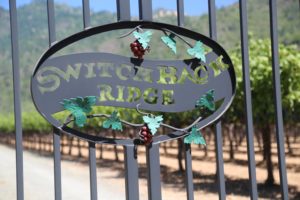
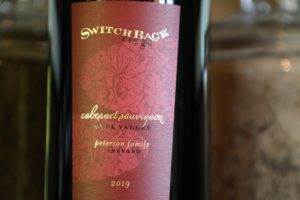
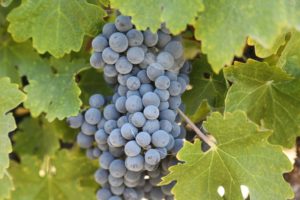 Switchback Ridge has a long family history in Napa Valley dating back to 1914 when property at the base of Dutch Henry Canyon south east of the town of Calistoga just off of the Silverado Trail was purchased by family relatives Elizabeth/Eliza and Mads Peterson. Mads immigrated to the U.S. in 1883 from Denmark and passed away in 1936; Eliza was originally from Ireland and passed away in 1966, 30 years after her husband. At that time of their purchase, there was a small Zinfandel vineyard planted on site but when Prohibition began in 1920 the property like much of the valley was converted to other crops – in their case to prunes and walnuts. During our visit to the property, we saw the old prune house, called the “old dipper”; it was most likely built soon after Elizabeth and Mads purchased the property. It was last used in 1989; unfortunately part of the exterior burned during the 2020 Glass Fire so this structure was finally torn down in late 2020.
Switchback Ridge has a long family history in Napa Valley dating back to 1914 when property at the base of Dutch Henry Canyon south east of the town of Calistoga just off of the Silverado Trail was purchased by family relatives Elizabeth/Eliza and Mads Peterson. Mads immigrated to the U.S. in 1883 from Denmark and passed away in 1936; Eliza was originally from Ireland and passed away in 1966, 30 years after her husband. At that time of their purchase, there was a small Zinfandel vineyard planted on site but when Prohibition began in 1920 the property like much of the valley was converted to other crops – in their case to prunes and walnuts. During our visit to the property, we saw the old prune house, called the “old dipper”; it was most likely built soon after Elizabeth and Mads purchased the property. It was last used in 1989; unfortunately part of the exterior burned during the 2020 Glass Fire so this structure was finally torn down in late 2020.
The prune trees were pulled out in 1989 and were replanted to a diversity of grape varieties. Today Peterson Family Vineyards are planted to approximately 21 acres of vines of the total nearly 100-acre property divided into 6 individual blocks all with the same row orientation. Three varieties grow here including 8 acres of Cabernet Sauvignon, 8 acres of Merlot and 5 acres of Petite Sirah divided into 2 acres of old vines planted in 1956 and 3 acres for the younger vines with budwood taken from the healthiest of the older vines. The old 2-acre block is the only part of their vineyard that is dry farmed. And during the sustained heat spike during Labor Day 2022, this part of their vineyard appeared to be the least affected by the extreme high temperatures.
Eliza and Mads had 6 daughters and three sons. But ultimately it was the daughters who took over the management of the property, Vera, Carrie and Mae.
Switchback Ridge was founded by John Peterson (Vera’s son) and his daughter Kelly Peterson-Holmes (who we originally met with at their vineyard) in 1999. The property and the wine brand are named after a ridge on the upper part of their property which contains a number of switchback hiking trails. Some of Napa Valley’s most intriguing terrain and vineyards are located at the upper end of Dutch Henry Canyon Road, a gated private road which connects to the Silverado Trail and borders one edge of their vineyard. And two prominent vineyard neighbors are nearby including Duckhorn’s Three Palms Vineyard and Hourglass’s Blueline Vineyard.
In 2013 Kelly’s sister Trish was looking around the attic of the old home on the property. She discovered the original purchase agreement in an old trunk of papers. It noted the value of the ranch was $11,850 in 1914 and Elizabeth and Mads had in part traded their home in San Francisco for the ranch. These original papers provided what was included with the sale of the property in great detail including listing all the animals and a Studebaker wagon. It also confirmed that grapes were already growing on the property in 1914 as it mentioned the revenue from the sales of grapes growing on site were not included with the sale of the property.
When a beautiful property has been under the ownership of the same family for more than 100 years it becomes a treasured piece of history. And if the property was under a different ownership, their historical Petite Sirah old block would most likely have been ripped out and planted to a variety that fetches more money in the valley such as Cabernet Sauvignon.
But respecting Napa’s heritage and their own family’s viticulture history, thankfully the family keeps these vines in the ground and while production is small, they continue to produce memorable wines each year. Their old Petite Sirah block, which also includes several to date unidentified mixed black varieties, is now over 65 years old.
For many years, John handled all of the primary vineyard management duties himself; as a child he helped plant some of the Petite Sirah vines. Because of his long history on this property, he has a real feel for the nuances of the property including soil types, microclimates and individual sections of the vineyard. Vineyard manager Jess Madrigal helped with the replants in the 1990s. For many years their vines were managed by Lopez Vineyard Management Company under the capable hands of Hector Lopez; his family has been farming in Napa Valley since the 1960s. Today the vineyard is managed by Matt Hardin and his team at Hardin Vineyard Management Company.
Well regarded winemaker Robert Foley made their wine from their inaugural vintage through 2018. For many years the Switchback Ridge wines were made at Robert’s own winery on Howell Mountain. And Robert used to purchase about half of the total grapes produced by the Petersen Family Vineyard each year. Mike Smith crafted the wines for the 2019 vintage. No wines were bottled in 2020 due to the resulting smoke from the Glass Fire followed by two much lower yielding vintages. And starting in 2021, Thomas Rivers Brown took over the winemaking for Switchback Ridge after he was introduced to Kelly by Matt Hardin. Thomas was already familiar with their wines having tasted through most of their previous vintages.
As of our latest update to this review, grapes are still sold to several other producers including Dakota Shy who produces a vineyard designate from their property. And since we first met with Kelly, Switchback Ridge has expanded their production and now produces several Napa Valley white wines. More recently they began purchasing white grapes from the historic Tofanelli Vineyard in Calistoga. The Peterson and the Tofanelli families have known each other for many years; Kelly recalls her mother used to visit the Tofanelli property to purchase eggs. Calistoga was a small tightly knit-community back then; it still is.
The fifth generation since Elizabeth & Mads purchased this land are also involved in Switchback Ridge.
Select Wines
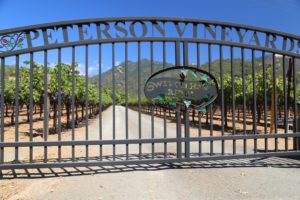
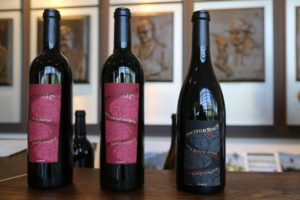 Their first commercial vintage was from 1999. They produce three estate red wines every year, sometimes 100% varietal but more often than not, slightly blended. These wines are: Merlot, Cabernet Sauvignon and Petite Sirah.
Their first commercial vintage was from 1999. They produce three estate red wines every year, sometimes 100% varietal but more often than not, slightly blended. These wines are: Merlot, Cabernet Sauvignon and Petite Sirah.
Merlot
The 2021 Switchback Ridge Merlot is a blend of 93% Merlot 5% Cabernet Sauvignon and 2% Petite Sirah; this is first time they have ever blended this variety into the Merlot. It is dark ruby; elegant is the first word we noted to describe the aromatics. Lovely. It is very floral including dried rose petals and violets. There are also scents of a sweet tobacco spice, red cherry, currant and a darker baking spice component which becomes more pronounced as the wine evolves in the glass. The palate offers flavors of dark plum, blackberry and cherry. The tannins are so gracefully rounded that one doesn’t immediately notice their presence; they are seamlessly integrated on the finish and slide across the palate like velvet with a chalk-like character. With Brown taking the winemaking reins, the percentage of new oak is much higher than it used to be, typically at least 75%. Their Merlot for this wine was planted in 1990.
In 2023 they started co-fermenting some of the Merlot with Petite Sirah.
Compared to their Cabernet Sauvignon and Petite Sirah, their Merlot tends to be a softer wine that is fairly balanced and approachable in its youth. The 2014 Switchback Ridge Merlot was blended with 10% Cabernet Sauvignon; it offers a diversity of aromas including darker fruits, black licorice, hints of cedar and tobacco smoke. Texturally this wine feels pleasant and is supported with a bright acidity that dances across the palate. The tannins are long lasting but are fairly well integrated into the somewhat earthy and seamless finish.
Cabernet Sauvignon
The 2021 Switchback Ridge Cabernet Sauvignon is blended with 2% Petite Sirah, only the second time in their history they have blended in this variety (the other time being in 2011). This wine is dark ruby and nearly opaque; the nose opens immediately to a scent of petrichor, the term to describe the smell of dry earth after the first rain – but this dissipates fairly quickly making way for aromas of violets, dark raspberry, a hint of mocha and dried tobacco leaf. Let the wine open and the fruit will become more expressive. The palate sports flavors of cherry, blackberry, dark mulberry and dark currant. It is layered without being heavy. Light on its feet. The tannins offer a creamy-like texture, are chalky, rounded and supple with some density.
The 2014 Switchback Ridge Cabernet Sauvignon is 100% varietal but a blend of two Cabernet Sauvignon clones including clone 337 which tends to offer bright acidity with floral and red fruit characteristics and clone 7 which contributes excellent structure, spicier notes and black fruits. Over the years they have tended to favor higher amounts of clone 337 in their estate Cabernet Sauvignon. This wine is deep ruby in the glass with aromas of dark fruit (mostly cherry and blackberry) with nuances of tobacco leaf and licorice. Shows excellent concentration with powerful fruit and fairly robust tannins that anchor a long finish. This is a full-bodied wine but well balanced between fruit, acidity and structure.
The 2019 Switchback Ridge Reserve is 80% Cabernet Sauvignon (60% clone 337 and 40% clone 7 – the percentage of each clones varies depending on the vintage), 15% Merlot and 5% Petite Sirah. This wine is deep ruby; the dark fruited aromatics include blackberry, plum, tobacco spice, toast, mocha, espresso, freshly tilled earth and dried herbs. The tannins are gravelly and lightly grainy with a light but lingering dusty character. This wine is layered on the palate in terms of both flavor and textural feel. It offers dark and sweetly fruited flavors including blackberry, boysenberry, cherry and plum along with dark chocolate. Both fruit and texture persist in tandem without either other outpacing the other on the finish. This wine is drinking in a sweet spot 5 years post vintage at the time of our tasting. Describing a wine as approachable with the term Reserve on its label and clocking in at nearly 16% alcohol is not always a description we are able to use. In 2021 only clone 7 was used in the Reserve bottling.
Petite Sirah
The winemaking changes starting in 2021 have resulted in a more refined expression of Petite Sirah, one that is less spice and earthy driven. This is most likely because of an increase in the level of sorting (now using an optical sorter) and aging in Burgundian barrels. Previously all grapes ranging from bunches that contained dried grapes (raisins) to those at various levels of ripeness, were all fermented together. And this is the wine you want to enjoy after the other Switchback Ridge wines. It is, “the nail in the coffin” as Kelly calls it; always a dark, inky and robust bottling.
The 2021 Switchback Ridge Petite Sirah is 100% varietal with 13% of this wine coming from the block planted in 1956. It is deep ruby, inky purple and opaque; its floral with aromas of violets, sage, Santa Rosa plum, dark cherry, boysenberry and blackberry. It features an intensity of fruit and tannins. This heady wine showcases a persistent finish dominated by both fruit and tannins. The flavors mirror the palate to some extent with blackberry, boysenberry, and dark plum along with dark licorice. A freshness and purity of fruit on the bouquet is clearly evident. The tannins are dense, grippy, and long lasting but not course and that is an important distinction. The finish lingers with notes of dried tobacco paper and a dusty character, both of which outrun the fruit.
The 2014 Switchback Ridge Petite Sirah is inky dark and jet black – the heart of darkness in the glass one might say. This wine is a blend of about 75% Petite Sirah from their newer vines with about 25% harvested from their old block. Shows dark and brooding on the bouquet with aromas of mushroom, forest floor, leather, a floral note (violets) and ripe blackberry. It is savory both on the bouquet and palate. The wine is big… no, that is too light of a description, it is a significant event across the palate and is dense, layered and extremely full bodied. Muscular and chewy tannins anchor intense fruit, with mouthwatering acidity – this is a finish that you will remember due to its persistence. We wonder what the 2013 vintage of this wine was like – a vintage that in general produced big red wines from Napa Valley which took plenty of time to open.
The 2005 Switchback Ridge Petite Sirah is all about the fruit. It is a robust wine – a significantly bigger wine than even their Cabernet Sauvignon and as a result it needs to breathe before being consumed. Decanting is recommended. It has chocolate overtones on the nose. It is aged in neutral oak so there are no dominating toasted oak, cocoa, vanilla or other characteristics that are often imparted with new oak barrel aging (depending on the cooper of course). Strong tannins show on the finish dominating a very youthful wine at the time of our tasting. Their Petite Sirah wines when consumed young show best when paired with well marbled steaks. They tend to age extremely well; during one tasting, Kelly’s husband Ray told us that some of the earlier vintages begin to shine 10-15 years after their vintage date.
810 Foothill Boulevard
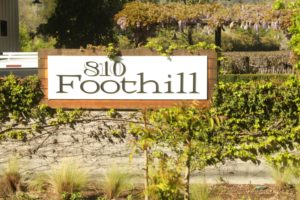
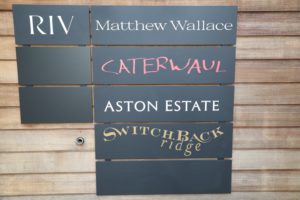 In December 2022 Switchback Ridge moved into the former T-Vine tasting room located at 810 Foothill Blvd, in Calistoga, just south of the center of town. This is directly next door to Rivers-Marie Winery. The entire property is 14 acres of which the majority of land is planted entirely to Cabernet Sauvignon but none of the grapes on site are used in Switchback Ridge’s wines.
In December 2022 Switchback Ridge moved into the former T-Vine tasting room located at 810 Foothill Blvd, in Calistoga, just south of the center of town. This is directly next door to Rivers-Marie Winery. The entire property is 14 acres of which the majority of land is planted entirely to Cabernet Sauvignon but none of the grapes on site are used in Switchback Ridge’s wines.
Switchback Ridge shares the space with several Thomas Rivers Brown winemaker projects including Matthew Wallace (co-owned by Matt & Alicia Hardin) and Caterwaul (co-owned by the Hardin’s and Brown). After these brands moved in, the name of the space was changed to 810 Foothill Boulevard, to reflect the site’s address. This property is owned by the Regusci family, the owners of Regusci Winery in the Stags Leap District.
For several years, visitors to the valley wanting to taste the Switchback Ridge Wines used to be able to do so by appointment at Phifer Pavitt Winery in Calistoga through a special collaboration between the owners of each of these properties. We have also seen their wines being poured on occasion at the Culinary Institute of America at Copia in downtown Napa.
Their mailing list is extremely popular and the waiting list to join this, can take up to several years. Locally you can sometimes find their wine at Cal Wine Stop in Calistoga. Incidentally this was the 350th Napa Valley based wine producer we visited and tasted with on this project. Total production each year has been as high as 3,000 cases but is usually between 1,500 and 2,000 cases. For more information and or to join their mailing list, visit: www.switchbackridge.com
Heron House
Switchback Ridge was a member of the Heron House in Yountville until December 11, 2022, when the Heron House closed permanently. We keep these notes and photographs for historical reference. The Heron House opened the day after Thanksgiving 2019 and was a retail wine tasting space in SoYo (South Yountville) which featured a select number of small-brand producers who did not maintain their own tasting rooms.
The Heron House was setup to feel like walking into someone’s living room – comfortable, cozy and inviting. The retail portion of the space was open during normal business hours and included mostly locally crafted products including select works of art. Two private tasting rooms were available by reservation. Several curated flights were offered, each containing wines from the various producers represented. Allow up to 90 minutes for a visit. Hours are subject to change, but as of our latest update to this review, this space is daily from 10am until 6pm with the last tasting appointment at 5pm.






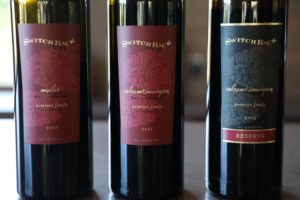
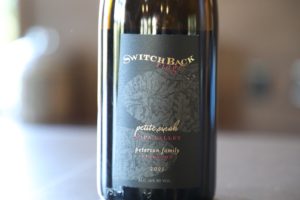
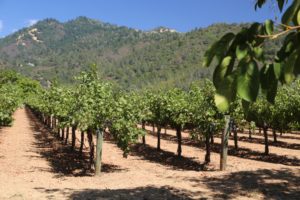
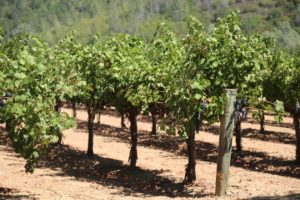
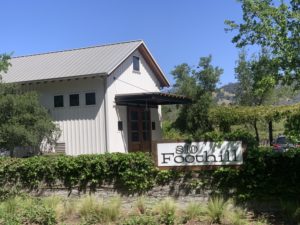
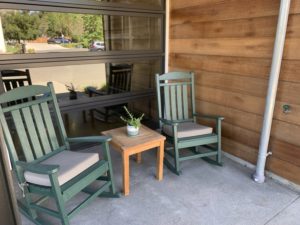
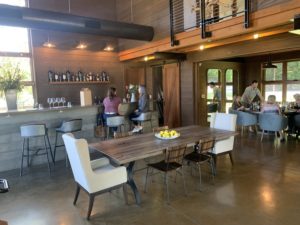
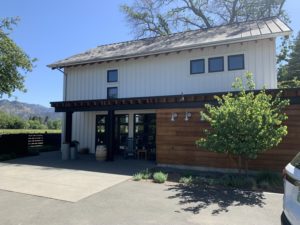

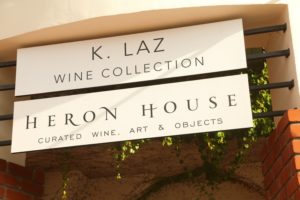
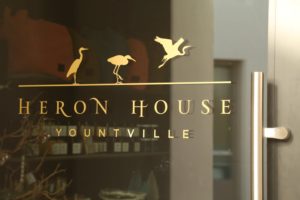

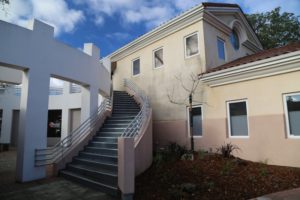
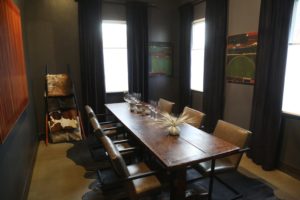


Leave a Reply